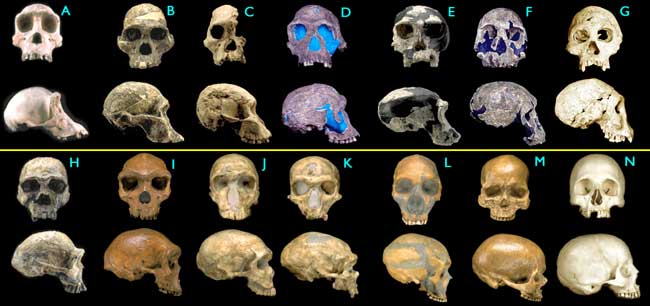
 |
Freethought & Rationalism ArchiveThe archives are read only. |
|
|
#1 | ||
|
Contributor
Join Date: Sep 2000
Location: Alibi: ego ipse hinc extermino
Posts: 12,591
|
Ladies and Gentlemen, let me introduce you to Theophilus.
Over in EoG, which I don�t often visit, I happened upon this thread. Where I read the following: Quote:
Quote:
Cheers, DT [Edited to replace repeated quote with the correct one!  ] ]
|
||
|
|
|
|
#2 | |||
|
Contributor
Join Date: Sep 2000
Location: Alibi: ego ipse hinc extermino
Posts: 12,591
|
Jobar, I?d be delighted to see Theo in E/C. But meanwhile, may I take these bits here? Oops, looks like I have!
 Quote:
Evolution is a change in allele frequency in a population over time. You will find that even most creationists do not deny that bit. Search for Peter Grant and Galapagos finches. Such evolution, up to and beyond speciation, has been observed. See Observed Instances of Speciation. You will also find that, though creationists rarely define ?kind?, it is generally considered to be some group much larger than species. ?Baraminologist? Kurt Wise is on record as saying it is more or less the Linnaean grouping of ?family?, which makes musk oxen and chevrotains, gemsboks and sheep the same kind, ie descended by evolution from a common ancestor. Creationists accept a big chunk of evolution. And evolution is also observed, overwhelmingly, in the pattern of the fossil record. No feathered dinos before theropods; no birds before either; then birds, for instance. Feel free to discuss this further in E/C. Quote:
 Quote:
Now. Get into E/C. Or else shut up about stuff of which you are ignorant. |
|||
|
|
|
|
#3 | |
|
Contributor
Join Date: Sep 2000
Location: Alibi: ego ipse hinc extermino
Posts: 12,591
|
Now, one might have hoped that he�d take the hint. But no, as we�ve seen before, ignorance and arrogance go hand in hand. Here is Theo�s reply.
Quote:
Cheers, DT |
|
|
|
|
|
#4 | ||||||
|
Veteran Member
Join Date: Feb 2001
Location: Quezon City, Philippines
Posts: 1,994
|
Quote:
The Biogeographic Evidence On chapter 12 of Origin, Darwin showed several facts on the geographic distribution of plants and animals. (See here). Species tend to be more similar to other species residing nearby, rather than to other species living in the same habitat. If god fashioned creatures to live and thrive in a certain ecological niche, then we should expect similar habitats, in different parts of the globe, to have the same, or nearly the same, species. Parallel habitats beget parallel species. Yet, as Darwin points out: Quote:
Quote:
Quote:
Quote:
Quote:
|
||||||
|
|
|
|
#5 | |
|
Veteran Member
Join Date: Feb 2001
Location: Quezon City, Philippines
Posts: 1,994
|
Quote:
BTW, you keep claiming that scientists insisting on evolution, " regardless of what the evidence shows." I'd like to see what the evidence does show. Please provide some examples. |
|
|
|
|
|
#6 | ||||||||||
|
Contributor
Join Date: Sep 2000
Location: Alibi: ego ipse hinc extermino
Posts: 12,591
|
Quote:
Or you could try Ecology and Evolution of Darwin�s Finches, or Weiner�s The Beak of the Finch Quote:
Quote:
One thing is clear: you have not read that page right through, or else didn�t understand it and ignored it. Please explain, for instance, these two: Quote:
Quote:
Perhaps this would be a good point at which for you to define �kind�. Quote:
Now will you answer the question? Quote:
Quote:
Ignoring A and N, since they are modern (and A not ancestral, just there for comparison): (B) Sterkfontein, South Africa (C) Sterkfontein, South Africa (D) Koobi Fora, Kenya (E) Olduvai Gorge, Tanzania (F) Koobi Fora, Kenya (G) Dmanisi, Georgia (H) Koobi Fora, Kenya (I) Kabwe, Zambia (J) La Ferrassie, France (K) La Chappelle-aux-Saints, France (L) Le Moustier, France (M) Les Eyzies, Dordongne, France Get an atlas. Get a photocopy of the page that shows the whole world. Get a felt tip pen. Put a blob where each of these places is. Notice anything? Quote:
(B) 2.6 million years (C) 2.5 million years (D) 1.9 million years (E) 1.8 million years (F) 1.8 million years (G) 1.75 million years (H) 1.75 million years (I) 300,000 - 125,000 years (J) 70,000 years (K) 60,000 years (L) 45,000 years (M) 30,000 years Quote:
We have a forum for Evolution / Creation matters. I couldn�t give a stuff who started it. Here is where it belongs, and here it now is. Get on with it. Put up or shut up. TTFN, DT |
||||||||||
|
|
|
|
#7 |
|
Veteran Member
Join Date: Nov 2001
Location: NCSU
Posts: 5,853
|
|
|
|
|
|
#8 |
|
Veteran Member
Join Date: Jul 2001
Location: Dana Point, Ca, USA
Posts: 2,115
|
RufusAtticus,
Very nice graphic. |
|
|
|
|
#9 |
|
Veteran Member
Join Date: Nov 2001
Location: NCSU
Posts: 5,853
|
Yeah, I know. Talk about a Chromosome Challenge.

|
|
|
|
|
#10 |
|
Veteran Member
Join Date: Jul 2001
Location: Orion Arm of the Milky Way Galaxy
Posts: 3,092
|
Speaking of chromosome challenges, Lilith on the talk.origins newsgroup has been doing a bit of it recently.
|
|
|
| Thread Tools | Search this Thread |
|